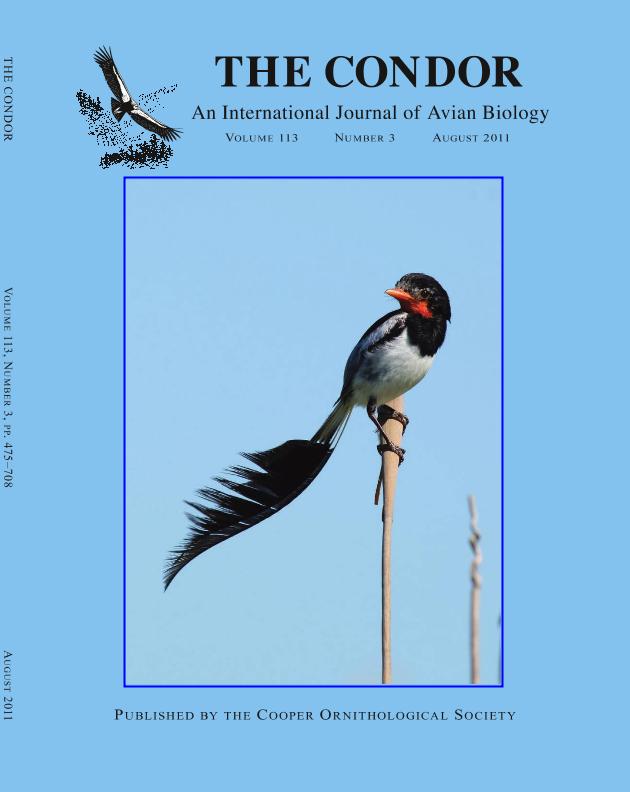Mostrar el registro sencillo del ítem
dc.contributor.author
Di Giacomo, Adrian Santiago

dc.contributor.author
Di Giacomo, Alejandro G.

dc.contributor.author
Reboreda, Juan Carlos

dc.date.available
2019-01-31T18:18:42Z
dc.date.issued
2011-08
dc.identifier.citation
Di Giacomo, Adrian Santiago; Di Giacomo, Alejandro G.; Reboreda, Juan Carlos; Male and female reproductive success in a threatened Polygynous species: the Strange-tailed Tyrant, Alectrurus risora; Cooper Ornithological Society; The Condor; 113; 3; 8-2011; 619-628
dc.identifier.issn
0010-5422
dc.identifier.uri
http://hdl.handle.net/11336/69119
dc.description.abstract
The Strange-tailed Tyrant (Alectrurus risora) is an endangered obligate grassland bird that inhabits savannas, wet grasslands and marshes in southern Paraguay and northeastern Argentina. We evaluated the extent of social polygyny, main measures of reproduction (clutch size, hatching success, and chick survival), and factors that influence nest success in this species. We also estimated the reproductive success of females and males by measuring the number and fate of nesting attempts by banded females and the number of females per a male's territory. More than 80% of the males were polygynous. Males defended contiguous territories of 2-2.5 ha that included the territories of up to four females. Females built the nest, incubated the eggs, and brooded and fed the chicks. On average, successful nests fledged 2.3 chicks. Nest survival over the entire cycle was 0.23 and decreased with nest age and time of breeding. Most females made two or three nesting attempts per breeding season and bred in the same area for 2 or 3 consecutive years. In contrast, males rarely were seen in the same area more than 1 year, suggesting sexual differences in mortality. As a result of this, the reproductive succcess of females and males was similar. Our findings indicate that although males are highly polygynous and nest success is low, the high turnover of males in successive breeding seasons and the high probability of females' renesting within and in successive breeding seasons reduce the variance in reproductive success of both sexes.
dc.format
application/pdf
dc.language.iso
eng
dc.publisher
Cooper Ornithological Society

dc.rights
info:eu-repo/semantics/openAccess
dc.rights.uri
https://creativecommons.org/licenses/by-nc-sa/2.5/ar/
dc.subject
Alectrurus Risora
dc.subject
Mark
dc.subject
Mating Systems
dc.subject
Nest Survival
dc.subject
Reproductive Success
dc.subject
Strange-Tailed Tyrant
dc.subject.classification
Otras Ciencias Biológicas

dc.subject.classification
Ciencias Biológicas

dc.subject.classification
CIENCIAS NATURALES Y EXACTAS

dc.title
Male and female reproductive success in a threatened Polygynous species: the Strange-tailed Tyrant, Alectrurus risora
dc.type
info:eu-repo/semantics/article
dc.type
info:ar-repo/semantics/artículo
dc.type
info:eu-repo/semantics/publishedVersion
dc.date.updated
2019-01-28T14:02:33Z
dc.journal.volume
113
dc.journal.number
3
dc.journal.pagination
619-628
dc.journal.pais
Estados Unidos

dc.description.fil
Fil: Di Giacomo, Adrian Santiago. Consejo Nacional de Investigaciones Científicas y Técnicas. Oficina de Coordinación Administrativa Ciudad Universitaria. Instituto de Ecología, Genética y Evolución de Buenos Aires. Universidad de Buenos Aires. Facultad de Ciencias Exactas y Naturales. Instituto de Ecología, Genética y Evolución de Buenos Aires; Argentina
dc.description.fil
Fil: Di Giacomo, Alejandro G.. Asociación Ornitológica del Plata; Argentina
dc.description.fil
Fil: Reboreda, Juan Carlos. Consejo Nacional de Investigaciones Científicas y Técnicas. Oficina de Coordinación Administrativa Ciudad Universitaria. Instituto de Ecología, Genética y Evolución de Buenos Aires. Universidad de Buenos Aires. Facultad de Ciencias Exactas y Naturales. Instituto de Ecología, Genética y Evolución de Buenos Aires; Argentina
dc.journal.title
The Condor

dc.relation.alternativeid
info:eu-repo/semantics/altIdentifier/doi/http://dx.doi.org/10.1525/cond.2011.100067
dc.relation.alternativeid
info:eu-repo/semantics/altIdentifier/url/https://bioone.org/journals/the-condor/volume-113/issue-3/cond.2011.100067/Male-and-Female-Reproductive-Success-in-a-Threatened-Polygynous-Species/10.1525/cond.2011.100067.short
Archivos asociados
